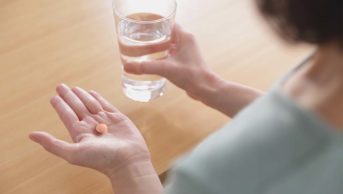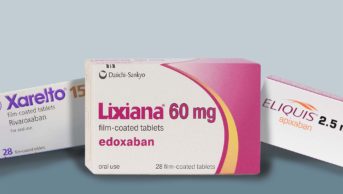This content was published in 2011. We do not recommend that you take any clinical decisions based on this information without first ensuring you have checked the latest guidance.
Frequent topics of discussion for patients on warfarin include concerns about side effects, missed doses, drug interactions, diet and alcohol consumption.
Side effects
Haemorrhage is the primary concern for patients on warfarin and they might query whether a bleed or bruise they are experiencing is cause for concern. Haemorrhage may be an indication of an elevated international normalised ratio. Bleeding can be minor, such as bleeding from gums, or can be potentially fatal, such as gastrointestinal or intracranial bleeding.
Management of bleeding depends on the severity and the location of the bleed. Minor bleeds may only require a lower dose or temporary omission of warfarin (eg, two days). In addition to stopping warfarin, treatment with oral or intravenous vitamin K may be required. The effects of vitamin K can take several hours to occur, so in the case of severe haemorrhage where the immediate restoration of functional clotting factors is required prothrombin complex concentrate (factors II, VII, IX and X) should be used.1
Patients should be advised that if they experience any increase in bruising or unusual or prolonged bleeding, they should seek medical advice either from their anticoagulation clinic or by attending an accident and emergency department.
Other side effects of warfarin include gastrointestinal disturbances (diarrhoea, nausea, vomiting), alopecia, rash and fatigue. For such non-bleed-related side effects alternative vitamin K antagonists, such as acenocoumarol and phenindione, may be indicated.
Less common side effects include hepatic dysfunction, jaundice, necrosis and purple toe syndrome.
Missed doses
In general, patients should be advised that they can take their warfarin up to six hours late. Thereafter the dose should be omitted and the appropriate dose of warfarin resumed at the usual time the next day. Historically patients have been instructed to take their warfarin at around 6pm. This is advised so that any recommended dose adjustments at a clinic appointment can be implemented the same day. However if a patient struggles to take medicines at this time it is reasonable for him or her to take the tablets at a more convenient time, for example in the morning with the rest of their morning tablets. The key point is that patients should take their warfarin at the same time each day.
Patients travelling to different time zones may ask about the timing of their dose. Time differences of up to six hours are relatively easy to manage. For instance, a patient travelling from London to New York (five hours behind London) who takes warfarin at 6pm GMT could continue taking it at 6pm GMT (1pm local time) or could take it at 6pm local time (11pm GMT).
Travel to destinations with a greater time difference requires more planning. Patients are advised to alter the timing of their doses gradually (eg, two hours earlier or later each day), either in the run up to their holiday. The reverse is done as the holiday draws to a close.
Interactions
Warfarin is almost entirely metabolised in the liver by the hepatic cytochrome P450 enzymes (CYP1A2, CYP3A4, CYP2C9) and numerous drug interactions have been documented with it. Pharmacokinetic metabolism interactions with induction and inhibition of the cytochrome P450 enzyme subtypes is a frequent mechanism of interaction, resulting in low and high international normalised ratios, respectively. In addition, concomitant use of drugs that have an impact on bleeding, such as non-steroidal anti-inflammatory drugs and selective serotonin reuptake inhibitors (antiplatelet activity), increase risk of bleeding with warfarin (ie, pharmacodynamic potentiation).
Because warfarin has a narrow therapeutic window, drug interactions can have a significant impact on anticoagulation control. It is essential, therefore, that patients are well educated about the potential implications of adding new medicines (including over-the-counter and herbal remedies) to their regimen. Patients must be advised to contact their anticoagulant clinic proactively (ie, they do not need to wait until their next scheduled appointment) and inform them of any medication changes — stopping as well as starting medicines — because the dose of warfarin may need to be adjusted.
The principle of management of interactions is to avoid the use of interacting drugs, but this is not always possible. In deciding a specific course of action, it is helpful to make a distinction between drugs that are themselves associated with bleeding or thrombosis and those that do not carry a risk of bleeding or thrombosis but can alter a patient’s INR.
The first category of drug interaction is harder to manage and is not always associated with a change in INR. Patients taking drugs associated with bleeding (eg, ibuprofen) or thrombosis (eg, hormone replacement therapy) should be advised to be particularly vigilant for symptoms of bleeding, bruising and thrombosis. Doses and treatment durations of these drugs should be kept to a minimum and regular assessment of the pros and cons of continued co-prescribing is appropriate.
Drug interactions resulting in altered INRs generally respond well to appropriate warfarin dose adjustments. Close monitoring (INR plus signs and symptoms of adverse events) and implementing dose adjustments as required are the mainstay of drug interaction management. The National Patient Safety Agency recommends that INRs should be tested four to seven days after an interacting drug is started or discontinued.
Managing drug interactions that affect INRs can be more problematic when the treatment involves short courses, such as antibiotics, rather than long-term therapy. A number of classes of antibiotics affect INRs via a variety of mechanisms, more commonly resulting in an elevated INR. If the response is predictable (eg, increased INR), proactive steps, such as missing a dose, may be recommended.
Sources of information for warfarin interactions with drugs and herbal preparations include the BNF, ‘Stockley’s drug interactions’ and ‘Stockley’s herbal medicines interactions’.
Warfarin in combination with antiplatelets
The increased use of warfarin and the expanding role for antiplatelet therapy in acute coronary syndrome has led to increased co-prescribing of warfarin and antiplatelets. There is an higher rate of major bleeding when antiplatelets are co-prescribed with anticoagulants, so regular assessment of the continued need for the individual agents as well as review of the risks versus benefits of combination antithrombotic therapy is appropriate. Patients should be advised of the increased risk of bleeding, even at therapeutic INRs, and reminded to be extra vigilant for signs of bleeding and bruising, particularly at the start of combination therapy.
OTC medicines
Patients may request OTC medicines that interact with their warfarin (eg, NSAIDs). Wherever possible, non-interacting alternatives should be recommended. When this is not effective or feasible, the decision to supply an interacting drug should consider the type of interaction, the likely duration of treatment and the patient’s anticoagulation history (ie, length of time on anticoagulation, their level of anticoagulation control or the frequency of adverse events and sensitivity to interacting drug where used previously). Patients for whom anticoagulation has been recently started and those with poor anticoagulation control should be referred to their GP when non-interacting alternatives are not available because their response to an interacting drug is likely to be unpredictable. A useful question for pharmacy assistants to ask when selling OTC medicines to patients taking warfarin is how long they have been taking it for.
When the decision is made to supply an interacting drug to a patient he or she should be advised to use the lowest dose for the shortest time. Patients and carers should be reminded to inform the anticoagulation clinic that they are taking an interacting drug — the clinic practitioners can then make a judgement as to whether the patient’s INR needs to be checked before the next scheduled appointment.
It is good practice for pharmacists to document their discussions with patients, GPs and anticoagulation clinics on the supply of interacting OTC and herbal medicines because it provides a clear audit trail of communication. In addition, if possible, the community pharmacist should annotate the patient’s yellow book with the name of the interacting drug and date of supply (in the comments column). This provides useful information for the anticoagulation clinic, particularly if the patient forgets to notify it.
Diet and alcohol
Most warfarin patients are well aware of the INR-lowering effect of many green vegetables. Patients should be advised to keep their diets broadly consistent rather than to avoid foods containing vitamin-K altogether. Indeed it has been shown that for some patients with poor INR control not associated with the usual causes of instability, vitamin K supplements (~100–200mg/day) can improve stability.2 Supplementation should be accompanied with close monitoring of the INR and warfarin dose adjustment.
Patients should be reminded that there are many foods other than green vegetables that contain vitamin K, such as liver, chick peas, avocado, olive oil and certain cereals. Patients should be advised to inform their clinic of any significant changes to their diet.
Binge drinking causes increased INR due to acute hepatic dysfunction, while chronic excessive alcohol intake reduces the INR due to increased P450-mediated metabolism of warfarin. Patients are advised to keep their alcohol consumption within recognised acceptable daily limits and keep weekly quantities consistent. Visual charts displaying units of different alcoholic beverages can be a useful aid to discussing acceptable levels of alcohol consumption with patients. If patients are worried that their drinking may have affected their INR they should contact their clinic for an early appointment. Cranberry juice should be avoided.
Patients should be advised to inform their anticoagulation clinic if they start to take vitamins (eg, vitamin C or E) or other supplements (eg, fish oil, ginger, garlic) because these can also affect anticoagulation.
Pregnancy
Warfarin (and the other vitamin K anticoagulants) cross the placenta and are associated with a characteristic embryopathy during the first trimester of pregnancy. The critical period of exposure is the sixth to ninth week of gestation. In addition, there is an increased risk of central nervous system abnormalities (during any trimester) and a risk of maternal, placental, fetal or neonatal haemorrhage during the second and third trimesters, but particularly during the last few weeks of pregnancy and at delivery.
Although unlicensed, low molecular weight heparins (LMWHs) have been successfully used in many indications as safe alternatives during pregnancy. However it has been difficult to establish an effective and safe regimen for patients with prosthetic valves and the best course of action remains uncertain for this group.
Women of child-bearing age should be advised of the risk of harm to the baby should they become pregnant and to use appropriate contraception. In addition, they should be told to inform the clinic if they plan to become pregnant so that their ongoing anticoagulation management can be discussed. For patients in the early stages of pregnancy, the key is to switch to LMWH promptly and always before six weeks’ gestation. The newer oral anticoagulants are not recommended in pregnancy.
The Royal College of Obstetricians and Gynaecologists recommends that, for short term indications, therapeutic anticoagulant therapy should be continued for the duration of the pregnancy and for at least six weeks postnatally and until at least three months of treatment has been given in total.3
Breastfeeding women can use warfarin and LMWH. They must ensure their babies have had their vitamin K injection.
Signposting
- In addition to the yellow oral anticoagulation pack, other useful sources of patient information include the Atrial Fibrillation Association, Anticoagulation Europe, British Heart Foundation and Life blood UK.
Key points
- Patients experiencing any increase in bruising or unusual or prolonged bleeding, should seek medical advice either from their anticoagulation clinic or by attending an accident and emergency department.
- Patients should take their warfarin at the same time each day. In general, they can take their warfarin up to six hours late. After that, the dose should be omitted and the next dose taken at the normal time.
- Patients should contact their anticoagulant clinic with changes to medication (stopping or starting), including over-the-counter, herbal products and supplements.
- Patients should be reminded that there are many foods that contain vitamin K other than green vegetables.
Further reading
- National Patient Safety Agency. Actions that can make anticoagulant therapy safer: alert and information for community pharmacists. Available at www.nrls.npsa.nhs.uk.
- Centre for Pharmacy Postgraduate Education. Anticoagulation: managing patients, prescribing and problems. (2008) Second Edition.
References
- Keeling D, Baglin T, Tait C, Watson H, Perry D, Baglin C et al and the British Committee for Standards in Haematology. Guidelines on oral anticoagulation with warfarin — fourth edition. British Journal of Haematology, 2011;154:311–24.
- Sconce E, Avery P, Wynne H, Kamali F. Vitamin K supplementation can improve stability of anticoagulation for patients with unexplained variability in response to warfarin. Blood. 2007;109(6):2419–23.
- Royal College of Obstetricians and Gynaecologists. Green-Top Guideline No. 37. ‘The acute management of thrombosis and embolism during pregnancy and puerperium. London: Royal College of Obstetricians and Gynaecologists, 2007.
The author has provided the following clarification:
A number of case reports have suggested that there is an interaction with warfarin and cranberry juice, most reporting an elevated INR as a consequence.1 The information booklet within the national yellow oral anticoagulation therapy pack advises patients on warfarin to avoid cranberry juice. Data to the contrary come from two small randomised trials which suggest that daily consumption of a moderate amount (240–250ml) of cranberry juice does not have a clinically significant effect on the INR in patients on warfarin (study length seven days and two weeks respectively).2,3 Because of the conflicting evidence, differences may be seen in the advice and practice of various anticoagulation clinics. In general, patients should be advised to maintain a consistent diet from week to week. Irregular/binge consumption of cranberry juice should be avoided. As with any other dietary change, patients should proactively inform their anticoagulation clinic if they are consuming cranberry juice.
References
- Medicines and Healthcare products Regulatory Agency/Committee on Safety of Medicines. Interaction between warfarin and cranberry juice. Current Problems in Pharmacovigilance 2004;30:10.
- Li Z. Seeram N, Carpenter C et al. Cranberry does not affect prothrombin time in male subjects on warfarin. Journal of the American Dietetics Association 2006;106:2057-61.
- Ansell J, Mc Donough M, Zhao Y et al. The absence of an interaction between warfarin and cranberry juice: a randomized, double-blind trial. Journal of Clinical Pharmacology 2009;49:824-30.


